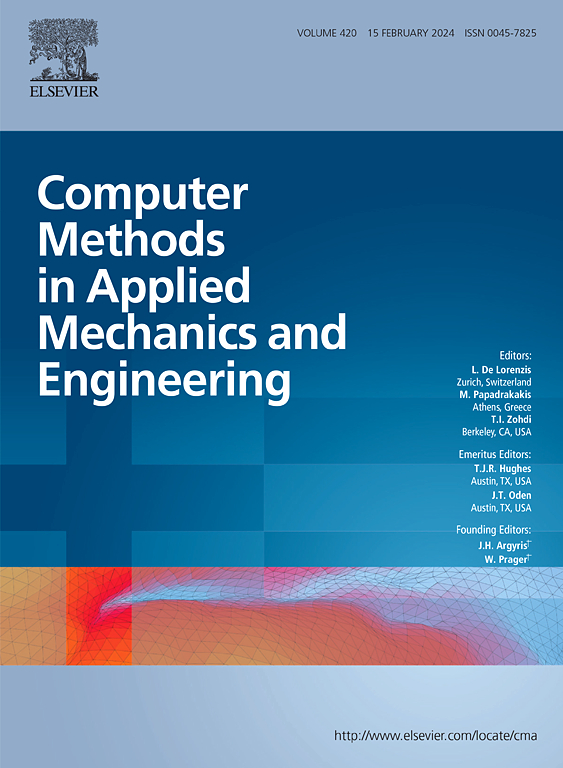Efficient fully discrete and decoupled scheme with unconditional energy stability and second-order accuracy for micropolar Navier–Stokes equations
IF 6.9
1区 工程技术
Q1 ENGINEERING, MULTIDISCIPLINARY
Computer Methods in Applied Mechanics and Engineering
Pub Date : 2024-12-28
DOI:10.1016/j.cma.2024.117692
引用次数: 0
Abstract
This article focuses on the numerical approximation of the micropolar Navier–Stokes (MNS) system for micropolar fluids, which consists of the Navier–Stokes equations and the angular momentum equations. A significant challenge in developing efficient numerical algorithms for this model is the complex coupling structure, involving both linear and nonlinear couplings. In particular, the linear coupling between flow velocity and angular velocity requires innovative methods for effective decoupling. Recognizing that the terms associated with this linear coupling constitute a diffusion term in the form of a complete square, we introduce a new nonlocal auxiliary variable and construct an ordinary differential equation with an ingenious structure. Reformulating the MNS system into an equivalent form allows us to decouple the linear coupling through explicit discretization. This novel method integrates the zero-energy-contribution decoupling method for handling nonlinear couplings, the second-order projection method for hydrodynamics, and the spatial finite element method, resulting in a fully discrete scheme that is unconditionally energy stable, fully decoupled, linear, and second-order accurate in time. Moreover, the proposed scheme is highly efficient, as only a few independent linear elliptic problems with constant coefficients need to be solved at each time step. The unconditional energy stability and well-posedness of the scheme are also established. Numerical simulations, including 2D/3D driven cavity flows and stirring of a passive scalar, are implemented to verify the stability and accuracy of the scheme, with the numerical results exhibiting interesting phenomena in micropolar fluids.
微极Navier-Stokes方程具有无条件能量稳定和二阶精度的高效全离散解耦格式
本文研究了微极流体的微极Navier-Stokes (MNS)系统的数值逼近,该系统由Navier-Stokes方程和角动量方程组成。为该模型开发有效的数值算法所面临的一个重大挑战是复杂的耦合结构,包括线性和非线性耦合。特别是,流速和角速度之间的线性耦合需要创新的方法来进行有效的解耦。认识到与这种线性耦合相关的项构成了一个完全平方形式的扩散项,我们引入了一个新的非局部辅助变量,并构造了一个结构巧妙的常微分方程。将MNS系统重新表述为等效形式允许我们通过显式离散来解耦线性耦合。该方法将处理非线性耦合的零能量贡献解耦法、流体力学的二阶投影法和空间有限元法相结合,得到了能量无条件稳定、完全解耦、线性、时间二阶精确的全离散格式。此外,该方案在每个时间步只需要求解几个独立的常系数线性椭圆问题,具有较高的效率。建立了该方案的无条件能量稳定性和适定性。数值模拟包括二维/三维驱动空腔流动和被动标量的搅拌,以验证该方案的稳定性和准确性,数值结果显示了微极流体中的有趣现象。
本文章由计算机程序翻译,如有差异,请以英文原文为准。
求助全文
约1分钟内获得全文
求助全文
来源期刊
CiteScore
12.70
自引率
15.30%
发文量
719
审稿时长
44 days
期刊介绍:
Computer Methods in Applied Mechanics and Engineering stands as a cornerstone in the realm of computational science and engineering. With a history spanning over five decades, the journal has been a key platform for disseminating papers on advanced mathematical modeling and numerical solutions. Interdisciplinary in nature, these contributions encompass mechanics, mathematics, computer science, and various scientific disciplines. The journal welcomes a broad range of computational methods addressing the simulation, analysis, and design of complex physical problems, making it a vital resource for researchers in the field.

 求助内容:
求助内容: 应助结果提醒方式:
应助结果提醒方式:


